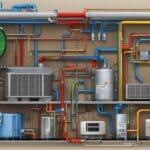Table of Contents
An HVAC system, short for heating, ventilation, and air conditioning, is vital for maintaining a comfortable indoor environment. Whether it’s a scorching summer day or a chilly winter night, a properly functioning HVAC system ensures that you stay cozy and content. This article will provide you with the fundamentals of HVAC systems, including how they work, the essential components, different types available, and practical tips for maintenance. So, let’s embark on a journey to explore the world of HVAC systems and discover the key to your comfort.
One of the primary purposes of an HVAC system is to control the temperature within a space, providing heating during colder months and cooling during hotter months. But it doesn’t stop there. HVAC systems also address the ventilation aspect, ensuring clean and fresh air circulation throughout the area, which is crucial for maintaining a healthy indoor environment. By understanding the basics of HVAC systems, you’ll be better equipped to make informed decisions about your heating and cooling needs.
In the next sections, we’ll dive into the essential components of an HVAC system, exploring the various heating and cooling methods in detail. We’ll also unravel the workings of an HVAC system, breaking down how each component contributes to its overall functionality. Additionally, we’ll explore the different types of HVAC systems available on the market, helping you choose the one that best suits your specific requirements.
Lastly, we’ll discuss the significance of regular maintenance for optimal performance and longevity of your HVAC system. With proper care and attention, you can improve energy efficiency, increase the lifespan of your system, and avoid costly repairs. So, let’s get started on our journey to unravel the mysteries of HVAC systems, from their fundamentals to practical tips for maintenance.
Essential Components of an HVAC System
An HVAC system is a complex combination of components designed to control the temperature, humidity, and air quality of a space. Understanding the essential components is crucial for homeowners and business owners alike who want to maximize the performance and efficiency of their HVAC system.
Forced-Air Systems
Forced-air systems are one of the most common types of HVAC systems. They utilize an electrically powered blower to distribute heated or cooled air throughout the space. This air is delivered through a network of ducts, which act as the distribution channels.
Properly functioning ducts play a vital role in the performance of forced-air systems. They ensure that the conditioned air reaches every corner of the space, providing consistent comfort. Regular maintenance and inspection of the ducts are essential to identify any leaks or blockages that could hinder the system’s efficiency.
Gravity Systems
Gravity systems rely on the principle that hot air rises and cold air sinks. These systems are primarily used for heating and are not designed for cooling purposes. The warm air is delivered through ducts located higher in the room, while the colder air returns through ducts positioned lower in the space.
Gravity systems are less common today but can still be found in older homes. They require careful positioning of the ductwork and often require larger ducts to accommodate the natural air movement. The blower motor, although not present in gravity systems, is not necessary as the natural convection process takes care of air circulation.
Radiant Systems
Radiant systems provide heating by directly warming the walls, floors, or ceilings of a space. This is achieved through hot water pipes or electric heating panels installed within the building’s structure. The warmth radiates from these elements and creates a comfortable environment.
Radiant systems offer several advantages, including consistent and efficient heating, reduced dust circulation, and energy savings. However, they are typically not used for cooling purposes and may require a separate cooling system to ensure optimal comfort during warmer months.
Blower Motor
A blower motor is an integral part of forced-air HVAC systems. It is responsible for pushing the conditioned air through the ducts and dispersing it evenly throughout the space. The blower motor ensures proper airflow, contributing to the efficiency and effectiveness of the system.
Regular maintenance of the blower motor is essential to prevent issues such as motor wear, debris accumulation, or motor failure. Professional inspection and cleaning of the blower motor will help maintain its performance and extend its lifespan.
In conclusion, HVAC systems consist of essential components like forced-air systems, gravity systems, radiant systems, as well as properly functioning ducts and blower motors. Each component plays a critical role in the operation and efficiency of the system. Regular maintenance and professional inspection are crucial in ensuring the optimal performance and longevity of an HVAC system.
How Does an HVAC System Work?
An HVAC system works by transferring heat from one area to another, providing heating or cooling as needed. It consists of various components that play vital roles in the system’s operation. Let’s take a closer look at each of these components and how they contribute to the functioning of an HVAC system.
Thermostat
The thermostat acts as the control center of the HVAC system. It detects temperature changes in the environment and signals the system to either activate or deactivate. The thermostat allows users to set the desired temperature and ensures that the system operates efficiently and effectively.
Burner
The burner is responsible for igniting the fuel source in the system. Whether it’s a furnace, boiler, or heat pump, the burner plays a crucial role in heating the air or water to the desired temperature. It ensures that the system produces the necessary heat for comfortable indoor conditions.
Furnace, Boiler, or Heat Pump
The furnace, boiler, or heat pump is where the heating process takes place. These components generate heat by burning fuel (such as gas or oil) or by utilizing electricity. They provide the warmth needed to raise the temperature of the air or water that will be distributed throughout the space.
Evaporator Coil
The evaporator coil is responsible for cooling the air in the system. It works by drawing warm air from the surroundings and passing it over the coil, which contains refrigerant. As the warm air comes into contact with the cold refrigerant, heat is absorbed, resulting in cool air that can be circulated back into the space.
Condensing Unit
The condensing unit is another crucial component in the cooling process. It is responsible for releasing the heat that was absorbed by the refrigerant in the evaporator coil. By compressing the refrigerant, the condensing unit raises its temperature, allowing the heat to be expelled to the outside environment.
Refrigerant Lines
Refrigerant lines are the pathways through which the refrigerant flows in the HVAC system. These lines connect the evaporator coil and the condensing unit, enabling the refrigerant to circulate and facilitate the transfer of heat. The refrigerant lines play a vital role in maintaining the proper flow and balance of the system.
Understanding how these components work together is essential for comprehending the overall functioning of an HVAC system. By efficiently transferring heat, the system can provide comfortable indoor conditions, whether it’s for heating during colder months or cooling during warmer months.
Now that we have explored the basic components of an HVAC system, let’s move on to Section 4, where we will discuss the different types of HVAC systems available.
Types of HVAC Systems
When it comes to HVAC (heating, ventilation, and air conditioning) systems, there are various options available, each with its own unique features and benefits. Understanding the different types of HVAC systems can help you make an informed decision regarding the best choice for your home or building. Let’s explore some of the most common types:
Cooling & Heating Split Systems
Cooling and heating split systems are the most widely used HVAC systems. They consist of two main components: an outdoor unit, known as the condensing unit, and an indoor unit, which houses the evaporator coil and blower. These systems provide both heating and cooling capabilities, making them versatile and suitable for year-round use.
Hybrid Split Systems
Hybrid split systems combine electricity and gas power to provide efficient heating and cooling. These systems utilize an electric heat pump for milder temperatures and switch to a gas furnace during colder weather. This hybrid approach optimizes energy efficiency, helping you save on utility costs.
Ductless Mini-Splits
Ductless mini-split systems are an ideal solution for spaces without ductwork or areas where traditional HVAC systems are impractical. These systems consist of small indoor units mounted on the wall or ceiling, connected to an outdoor unit. They offer high energy efficiency, individual temperature control, and quiet operation.
Packaged HVAC Systems
Packaged HVAC systems combine all the necessary components, including the compressor, condenser, and evaporator, into a single unit. These systems are commonly used in homes with limited indoor space, such as apartments or small houses. They are easy to install and maintain, making them a convenient option for many homeowners.
Geothermal HVAC Systems
Geothermal HVAC systems utilize the constant temperature underneath the Earth’s surface to heat and cool homes. This eco-friendly technology relies on a network of underground pipes filled with a water-based solution or refrigerant, known as a ground loop. Geothermal systems are highly energy-efficient, reduce carbon emissions, and provide consistent comfort throughout the year.

Having a clear understanding of the various types of HVAC systems can help you choose the most suitable option for your specific needs. Whether you opt for a cooling and heating split system, a hybrid split system, a ductless mini-split, a packaged HVAC system, or a geothermal HVAC system, it’s essential to consider factors such as energy efficiency, cost-effectiveness, and the size and layout of your space.
Maintaining Your HVAC System
Regular maintenance is crucial to ensure the optimal performance and longevity of your HVAC system. By following a few simple tips, you can keep your system running efficiently and prevent costly repairs.
Start with the thermostat. Make sure it is set at the right temperature for both heating and cooling seasons. Adjusting the settings according to your comfort needs can help save energy and reduce utility bills.
Clean or replace filters regularly. Dirty filters restrict airflow, leading to decreased efficiency and increased energy consumption. Check them monthly and clean or replace them as needed to maintain good air quality in your home.
Inspecting and repairing ductwork is also essential. Leaky ducts can result in significant energy loss and reduced system performance. If you notice any leaks or gaps in the ductwork, seal them promptly to improve efficiency and ensure consistent airflow throughout your home.
Lastly, don’t forget to schedule professional maintenance inspections. A qualified HVAC technician can perform a thorough inspection and identify any underlying issues that may affect your system’s performance. Regular professional inspections can catch problems early on, preventing bigger and costlier repairs down the line.
By following these maintenance tips for your HVAC system, you can improve energy efficiency, extend the lifespan of your equipment, and enjoy a comfortable indoor environment all year round.
FAQ
What is an HVAC system?
An HVAC system stands for heating, ventilation, and air conditioning. It is responsible for maintaining a comfortable indoor environment by regulating temperature, humidity, and air quality.
What are the essential components of an HVAC system?
The essential components of an HVAC system include forced-air systems, gravity systems, radiant systems, ducts, and blower motors. These components work together to distribute heated or cooled air throughout a space.
How does an HVAC system work?
An HVAC system works by transferring heat from one area to another. It uses a thermostat to detect temperature changes, a burner to ignite the system, and a furnace, boiler, or heat pump to heat the air or water. The heat is then distributed through various components, including the evaporator coil, condensing unit, and refrigerant lines.
What are the different types of HVAC systems?
There are various types of HVAC systems available, including cooling and heating split systems, hybrid split systems, ductless mini-splits, packaged HVAC systems, and geothermal HVAC systems. Each type has its own advantages and disadvantages.
How should I maintain my HVAC system?
Regular maintenance is crucial for optimal performance and longevity of an HVAC system. This includes changing thermostat settings, cleaning or replacing filters, inspecting and repairing ductwork, and scheduling professional maintenance inspections.







